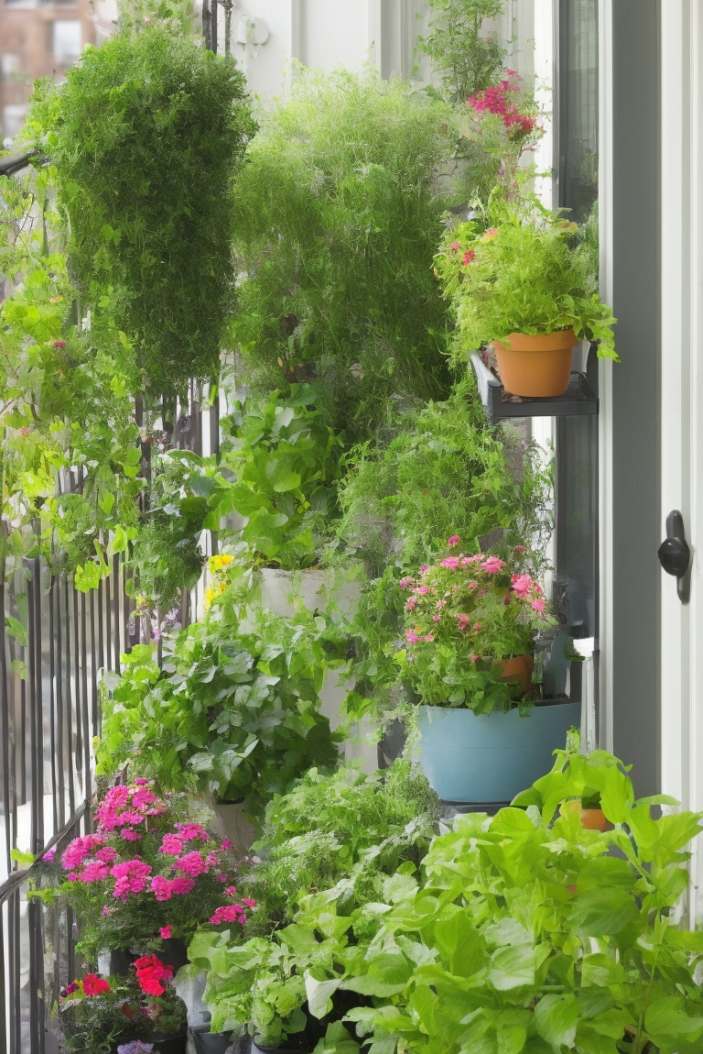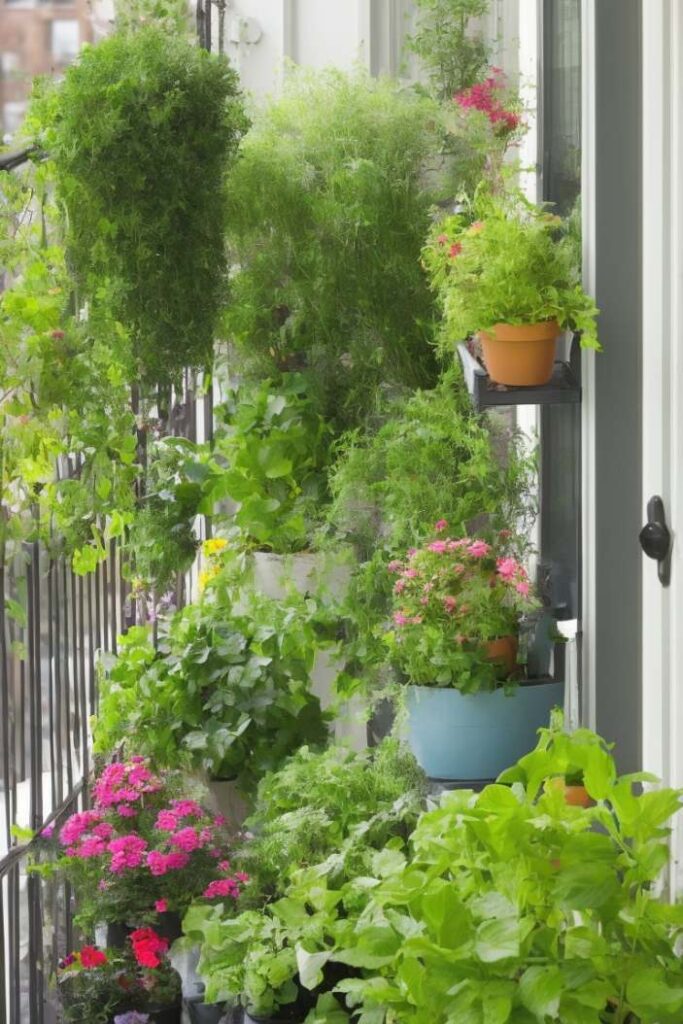
Welcome to the wonderful world of apartment gardening! Growing plants in an urban home can completely transform a space and make it feel more like a lush, green paradise. Gardening in apartments comes with its own unique challenges, but the benefits for well-being, fresh produce, and home decor make it well worth the effort. This beginner’s guide will walk you through everything you need to know to create a thriving indoor or outdoor apartment garden. Let’s get started greening up your space!
Gardening in apartments allows you to reap many of the same benefits as traditional gardening while working within a smaller footprint. Adding plants helps purify indoor air, reduces stress, provides fresh herbs and veggies, and allows you to connect with nature. With the right approach, virtually any apartment has the potential for growing plants with proper sunlight, suitable containers, and a little TLC. Don’t let limited space stop you from flexing your green thumb!
The key takeaways for success are:
- Assess sunlight, space, and airflow in your apartment
- Choose compact, low-maintenance plants suited to containers
- Select containers with good drainage and appropriate size
- Provide consistent watering and fertilization
- Adjust plant care for indoor vs. outdoor spaces
- Get creative with layouts, displays, upcycled planters
- Enjoy fresh herbs, fruits, and veggies grown at home!
Assessing Your Space
When planning an apartment garden, the first step is assessing the unique conditions of your space. This will allow you to select suitable plants and determine the best areas to focus your efforts.
Start by identifying sources of natural sunlight in each room – south and west-facing windows are ideal. Also check for potential growing areas like balconies, patios, and rooftops.
Consider airflow and humidity levels which can impact plant health. Finally, check if there are any weight restrictions for balconies or rooftops that may limit large pots.
Pay special attention to the amount and quality of light. Most edible plants require at least 4-6 hours of direct sun daily. If your space lacks sufficient sunlight, focus on low-light houseplants or invest in grow lights.
You can map sunlight in your space over a few days to identify optimal garden locations. With a bit of planning, even north-facing or interior rooms can support thriving container plants!
Checklist for Assessing Your Apartment Garden Space:
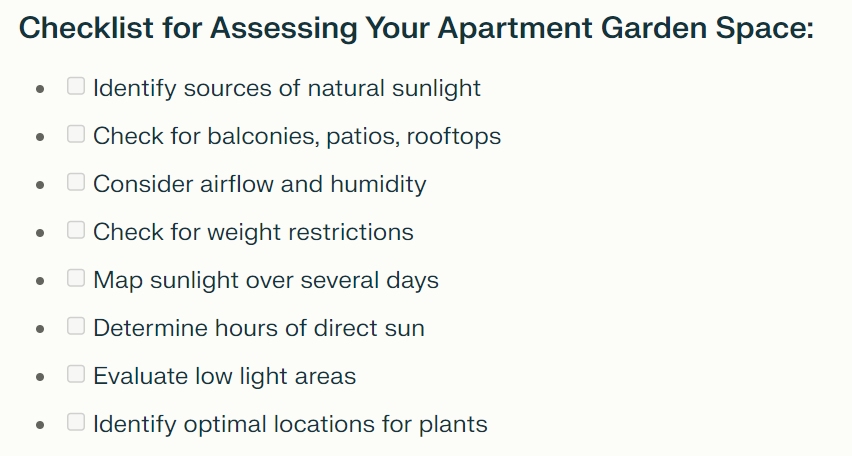
Choosing Suitable Plants
Selecting the right plants is key to success when gardening in apartments. Look for compact, slow-growing varieties that will thrive in containers and indoor conditions.
Prioritize easy-care, low-maintenance plants that are suitable for beginner apartment gardeners. When selecting plants, first consider the specific conditions of your space – especially the amount and quality of natural light. South or west-facing windows are ideal for sun-loving edible plants that require at least 4-6 hours of direct sunlight daily.
For low-light areas, focus on shade-tolerant houseplants like pothos, philodendrons, and Chinese evergreens. If you lack sufficient natural light, invest in grow lights to support more plant varieties. Always check that the mature size of the plant suits your available space – miniature and dwarf varieties are great for tight spots.
Great Plants for Apartment Gardening
| Category | Low Light Varieties | Good Light Varieties |
|---|---|---|
| Herbs | Basil, mint | Parsley, sage, thyme |
| Vegetables | Lettuce, kale | Tomatoes, peppers, radishes |
| Fruits | Dwarf citrus, berries, figs | |
| Flowers | Peace lilies, orchids | African violets, succulents |
When visiting nurseries and garden centers, ask questions to ensure you select plants suited to container growing. Seek advice on the best varieties for your USDA Hardiness Zone and growing conditions. With the proper plant selection and care, even novice gardeners can experience success growing indoors!
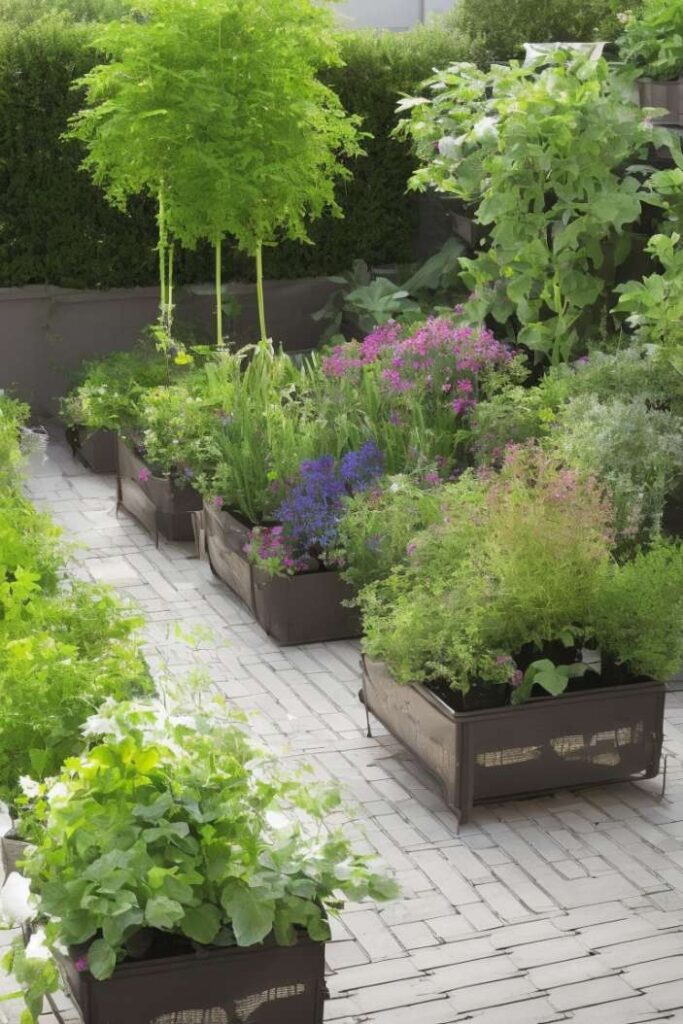
Selecting the Right Containers
Containers are vital for growing plants in apartments. You’ll need pots with drainage holes to prevent overwatering. Self-watering containers are great for extended travel. For edibles, use food-safe materials like wood, plastic, and ceramic.
Dark colors absorb heat while light colors stay cooler – factor in sun exposure when choosing. Match containers to mature plant size – bigger is better for roots. Consider self-watering pots and saucers to reduce watering.
How to select the Right-Size Containers:
| Plant Size | Example Plants | Minimum Container Size |
|---|---|---|
| Small | Herbs, lettuce, succulents | 4-6 inches |
| Medium | Tomatoes, peppers, flowers | 8-12 inches |
| Large | Citrus trees, shrubs | 14+ inches |
- Choose containers at least 2 inches wider than the plant’s mature root ball
- Depth should allow for 6-12 inches of soil below the roots
- Bigger pots allow more room for root growth
- Avoid potting big plants in small containers
- Use larger containers for root vegetables and vines
- Self-watering pots can be slightly smaller than traditional containers
- Match lightweight pots for balconies with weight restrictions
Following these size guidelines ensures plants have enough room for healthy root development. Overcrowded roots lead to stunted growth and issues with watering.
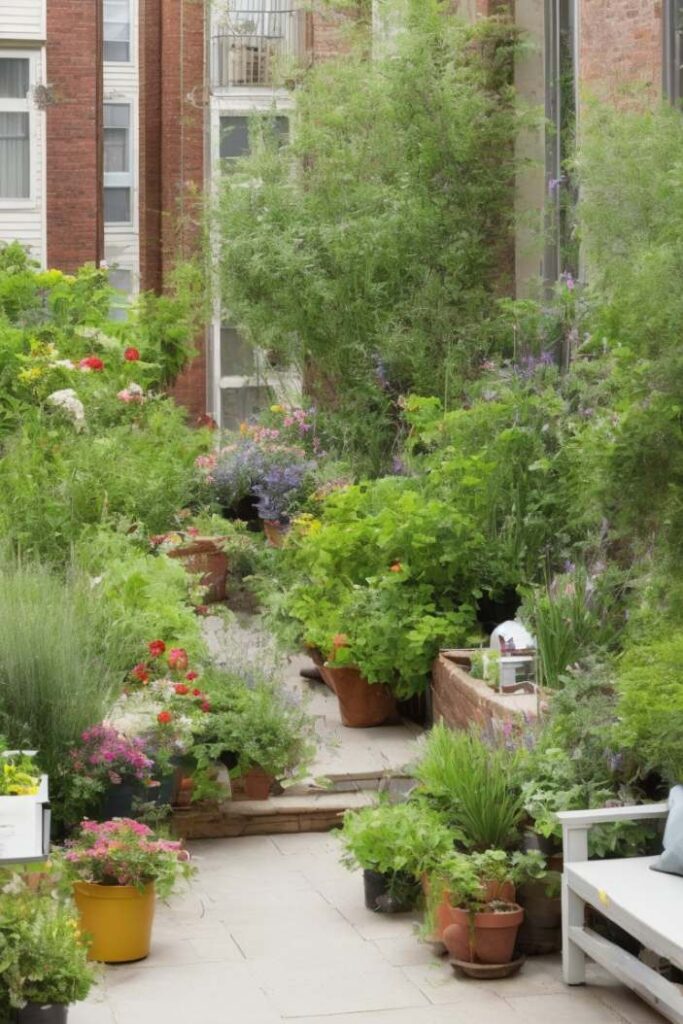
How to Manage Containers:
Elevate containers off the ground to improve drainage. Add casters to larger pots for mobility. Select lightweight planters for balconies with weight limits. Always check containers for cracks and proper drainage before planting.
When selecting containers, keep in mind that the material affects watering frequency. Unglazed terra cotta dries out the fastest while plastic retains moisture well. Match material to the plant’s preferences – cacti do well in terracotta and tropicals favor plastic.
Edibles Containers:
For edibles, use food-safe containers like wood, plastic, and ceramic. Avoid treated wood or lead-based glazes. Consider breathable fabric pots that promote air pruning of roots. Add trays under pots to protect surfaces from water damage and stains.
Group containers together to create a mini garden for herbs or vegetables. Use trellises and cages to support vining crops. Hang pots along railings or walls to maximize vertical space. With the right vessels and care, your plants will thrive in their new homes!
Caring for Container Plants
Caring for container plants has a few key differences from in-ground gardening. The restricted root zone requires more frequent watering and fertilizing. Check soil moisture daily – containers dry out faster. Apply a balanced liquid fertilizer every 2-4 weeks during the growing season.
Group plants with similar needs like sun-lovers versus shade plants. Move containers to optimize sun exposure. Prune and trim plants to keep them compact and manageable. Transition plants indoors and outdoors based on seasonal conditions. Invest in grow lights to supplement natural light if needed. With proper care, container plants can thrive indoors and out!
One key to success is using an appropriate potting mix, not garden soil. Potting mixes are lightweight, fast-draining, and provide nutrients. Make sure containers have drainage holes to prevent soggy soil. Elevate pots off the ground to improve drainage.
Check soil moisture frequently, especially with terra cotta pots which dry out quickly. Water thoroughly until it drains from the bottom. Fertilize more often than in-ground plants. Group plants according to their sun and water preferences.
Prune overgrown or leggy plants to keep them compact. Bring containers indoors or under cover during extreme weather. Rotate pots to ensure even sun exposure. Proper watering, fertilizing, and care keep container plants thriving in any space!
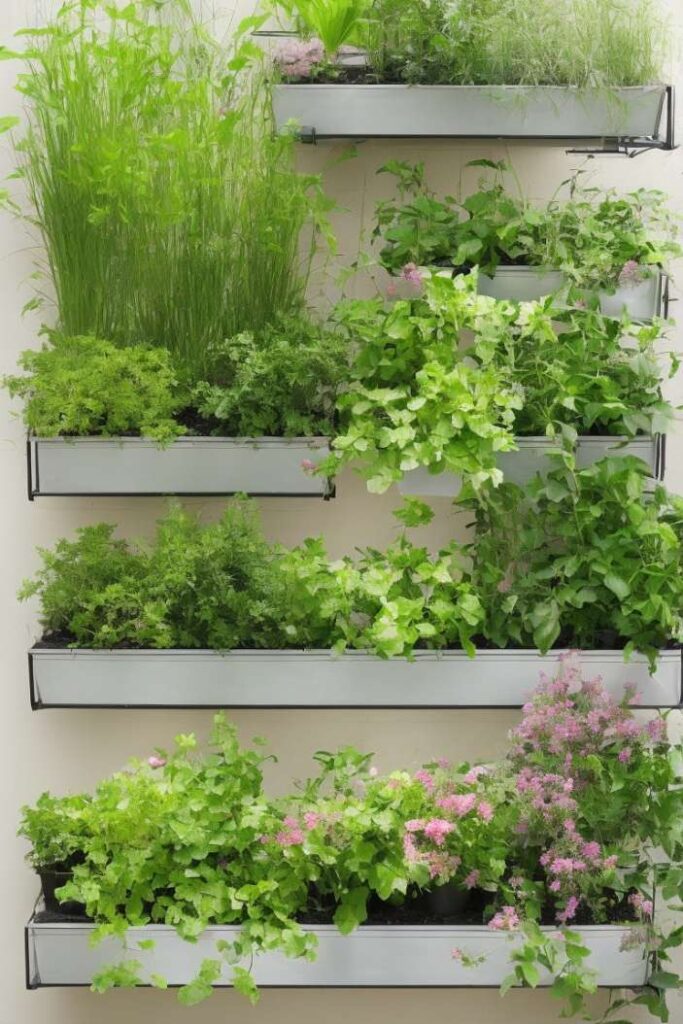
Growing Herbs and Vegetables
One of the joys of gardening in apartments is having fresh edibles right at your fingertips. Many herbs and vegetables are well-suited to container growing.
Try compact varieties like thyme, parsley, basil, and lettuce which yield continually when harvested often. Tomatoes and peppers can thrive with sufficient sunlight and room for roots to spread.
Support vining crops like cucumbers and beans with trellises. Radishes, kale, spinach, and green onions grow quickly from seed. Strawberries do well in hanging planters. Follow proper spacing guidelines to avoid overcrowding. With the right care, you can enjoy the homegrown flavor all season long.
When choosing edibles, select compact, determinate varieties suited to containers. Dwarf and patio cultivars are bred for small spaces. Cherry tomatoes yield well without taking up much room. Herbs like thyme and oregano grow happily in just 6-8 inches of soil.
Provide at least 6 hours of sun for vegetables like tomatoes, peppers, beans, and cucumbers. Supplement natural light with grow lights if needed. Add vertical space with wall-mounted planters and vertical gardens. With proper care, even a small apartment can produce bountiful harvests!
Herbs & Vegetables by Height
| Short Plants | Medium Plants | Tall Plants | |
| Herbs | Thyme, oregano, chives, parsley, basil, mint | Rosemary, sage, lavender | – |
| Vegetables | Lettuce, spinach, kale, radishes, green onions | Carrots, peppers, bush beans, bush tomatoes, strawberries | Pole beans, tomatoes, cucumbers, zucchini |
Herbs & Vegetables by Light and Water Needs:
Here is a matrix categorizing the apartment gardening plants by sunlight and watering needs
| Low Sun | Medium Sun | High Sun | |
| Low Water | Lettuce, Spinach, Kale, Mint, Lemon Balm | Thyme, Oregano, Sage | Rosemary, Peppers, Eggplant |
| Medium Water | Carrots, Pole Beans, Tomatoes | Parsley, Cilantro | Bush Beans, Zucchini |
| High Water | Cucumbers |
- Low Sun: Less than 4 hours of direct sun
- Medium Sun: 4-6 hours of direct sun
- High Sun: More than 6 hours of direct sun
- Low Water: Water when the top 1″ of soil is dry
- Medium Water: Water when the top 2-3″ of soil is dry
- High Water: Keep soil consistently moist
Plants by Difficulty Level
| Difficulty | Herbs | Vegetables |
|---|---|---|
| Beginner | Basil, chives, mint, parsley | Lettuce, spinach, radishes, green onions |
| Intermediate | Oregano, rosemary, thyme | Tomatoes, peppers, carrots |
| Advanced | Sage, lavender | Eggplant, celery, zucchini |
- Beginner plants are fast-growing and more forgiving. They require minimal care.
- Intermediate plants need more specific growing conditions and attentive care.
- Advanced plants can be tricky in containers and have higher care needs.
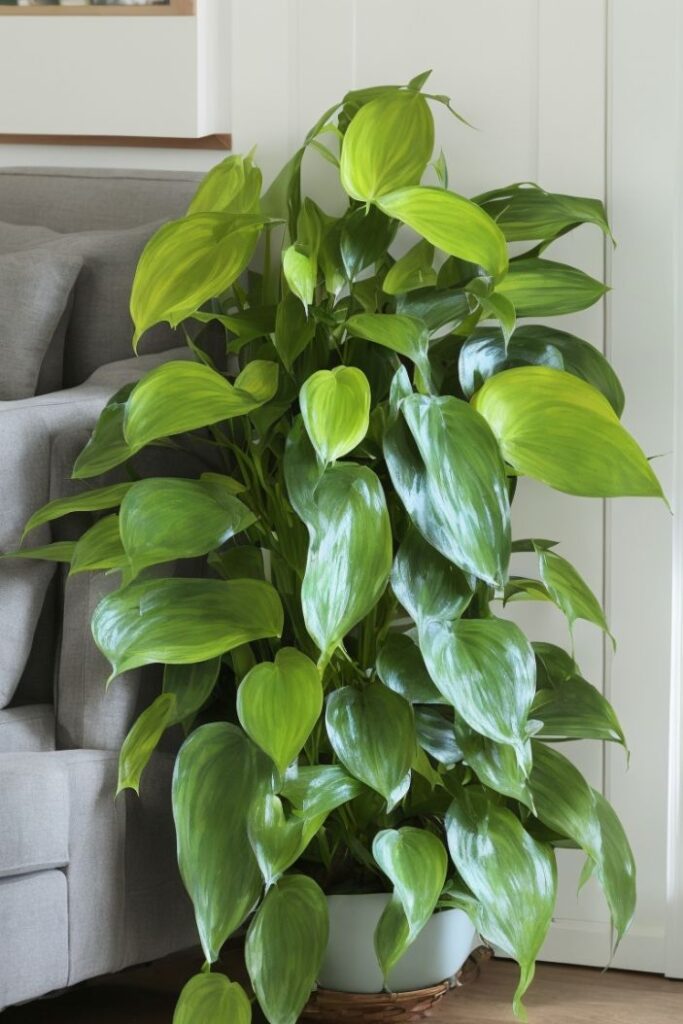
How Can I Apply Container Planting Tips in an Apartment Setting?
When living in an apartment, container planting is a great way to bring greenery indoors. Knowing when to repot container plants is important for their growth. Choose the right size containers, use good quality soil, and water properly. Utilize vertical space and consider the amount of sunlight available for your plants.
Bringing Nature Indoors
In addition to edibles, houseplants are a great way to bring natural beauty indoors. Plants like orchids, ferns, peace lilies, and succulents thrive in indoor conditions. Grouping houseplants creates a pleasant green oasis and improves air quality.
Consider creating a living wall or mini-greenhouse display with air plants or tropical varieties. Caring for indoor trees like dwarf citrus lets you enjoy fresh fruit. Strategically place plants to decorate living spaces or improve views from windows.
Remember to situate plants appropriately based on their light and humidity requirements. South-facing rooms are ideal for sun-loving plants. Supplement with grow lights as needed. Use pebble trays and daily misting for humidity-loving varieties.
Rotate plants regularly so all sides receive sufficient light. Wipe leaves often to prevent dust buildup. Prune and trim overgrown plants to maintain their shape and health. With the right care, houseplants can transform any indoor space into an urban oasis!
Getting Creative with Design
One of the most rewarding parts of apartment gardening is letting your creativity run wild! From funky containers to mini theme gardens, or terrariums![]() , there are endless possibilities to explore.
, there are endless possibilities to explore.
Try planting in an old ladder, crate, or basket for a fun upcycled planter. Hang trailing vines or tabletop herbs in macrame hangers. Use magnets to attach small containers to fridges or metal surfaces.
Paint and decorate pots to match your home’s style. Create a mini fruit or vegetable garden with a trellis and raised bed frame. Use a windowsill herb garden or succulents to add personality to your kitchen.
Get innovative with vertical space. Mount shelves or wall-mounted planters to grow up. Use a freestanding plant tower to add height. Try a wall-mounted living picture frame or vertical garden.
Let your imagination run wild and find creative ways to incorporate plants throughout your living space. Apartment gardening allows you to fully customize your indoor jungle. Don’t be afraid to experiment with unique containers and displays that show off your personal flair!
Dealing with Pests and Diseases
Just like any garden, container plants can sometimes experience issues with pests and diseases. Mealybugs, fungus gnats, mites, and aphids are common indoor plant pests.
Prevent this by inspecting new plants closely, using a sterile potting mix, and allowing the soil to dry out between waterings. Introduce beneficial insects like ladybugs or lacewings to manage pests naturally.
Neem oil, insecticidal soap, and horticultural oils can help treat infestations. Isolate and prune affected plants to prevent spreading. Maintaining optimal growing conditions and plant health is key to preventing problems.
Check plants regularly for signs of disease like spots, wilting, or discoloration. Improve air circulation and reduce humidity to prevent fungal and bacterial diseases. Sanitize tools between uses to limit spread.
Remove severely infected plants to protect others. Use organic fungicides derived from plants when needed. Proper watering, sunlight, and cleanliness keep apartment plants thriving and healthy.
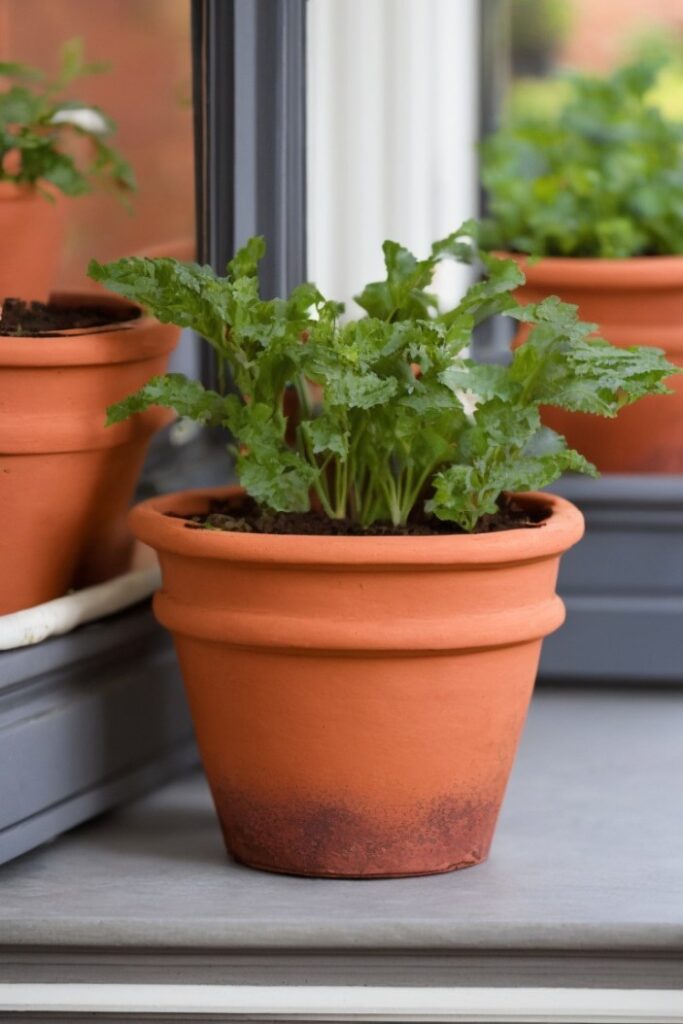
How Can Ideal Soil Mixtures for Containers Help Beginners with Apartment Gardening?
Ideal soil mixtures for containers are crucial for apartment gardening beginners. The right soil combination ensures thriving plants in ideal soil, providing essential nutrients and proper drainage. With the mix, beginners can enjoy a successful apartment garden, cultivating a variety of plants and vegetables with ease.
Conclusion
Bringing the joy of gardening into your apartment![]() is incredibly rewarding. Start by assessing your space and selecting compact, low-maintenance plants suited to containers. With proper light, water, soil, and care, your plants will thrive indoors. Furthermore, it’s essential to understand the specific needs of your chosen plants, as each type may require different levels of light and moisture. Researching indoor plant care tips can help you maintain a healthy environment for your green companions. Don’t forget to rotate your plants occasionally to ensure even growth and prevent them from leaning towards the light source.
is incredibly rewarding. Start by assessing your space and selecting compact, low-maintenance plants suited to containers. With proper light, water, soil, and care, your plants will thrive indoors. Furthermore, it’s essential to understand the specific needs of your chosen plants, as each type may require different levels of light and moisture. Researching indoor plant care tips can help you maintain a healthy environment for your green companions. Don’t forget to rotate your plants occasionally to ensure even growth and prevent them from leaning towards the light source.
Add fresh edible herbs, vegetables, and fruits to enjoy homegrown flavor. Houseplants naturally purify the air and create a peaceful oasis. Get creative with unique pots, vertical gardens, wall displays, and hangers. A bit of effort transforms your apartment into a lush urban jungle.
Follow these tips to create a flourishing garden that benefits your health, productivity, and happiness. Soon your home becomes a relaxing botanical haven brimming with life. The initial time investment is well worth it.
Happy gardening!

